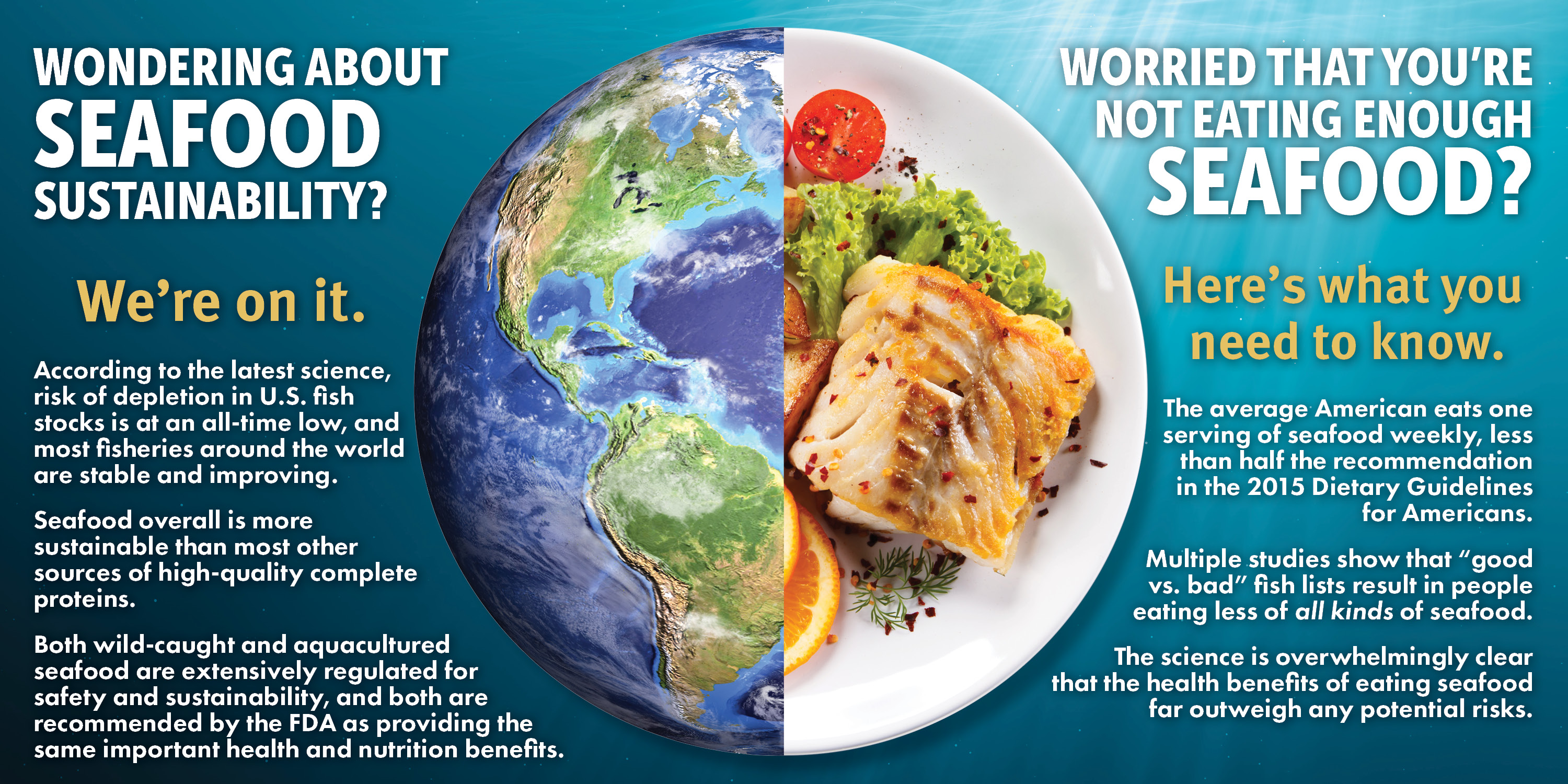Everything You Need to Know About Sustainable Seafood, Wild-Caught, and Farm-Raised (Aquaculture) Fish
Click Here: Sustainable Seafood Side by Side PDF
Thinking About Sustainable Seafood
We get it. There is a lot of confusing and contradictory messaging on seafood sustainability out there. You want reliable, accurate, and straightforward information about how much and which kinds of sustainable seafood you should be eating—and, if there is anything you should avoid. With more and more farm-raised fish options available, you also want to know that aquacultured fish is just as good for you as wild-caught.
You care about seafood sustainability, too, so you want to know which sourcing methods are ethical and environmentally responsible.
Lastly, if you’re pregnant, breastfeeding, have other nutrition sensitivities, or you are giving personal or professional guidance to someone who does, you want to make sure that all of this is safe and healthy for you and those you care about.
Don’t worry, we’ve got you!
Here is what you need to know.
A Great Majority of Seafood Is Sustainable
The news on seafood sustainability is unequivocally, inarguably GOOD. The majority of fish stocks around the world, including the most widely-eaten varieties in the U.S., are healthy and thriving.
That’s thanks to decades of hard work from international organizations dedicated to preserving and improving fishing practices and management.
Meanwhile, overfishing in the United States is at an all-time low.
The internet is full of confusing and complicated guides and lists, often from less than reputable sources. But you’re not on your own when it comes to seafood sustainability.
The reality is that seafood retailers and restaurants are already putting a huge amount of work into ensuring their products come from sustainable sources. Many of the largest grocery stores have great sustainable seafood policies you can view online. If you are shopping at one of these stores, you should feel confident about your purchases.
What About Farm-Raised (Aquaculture) Fish?
Farm-raised (or aquaculture) fish is a healthy choice. It provides heart-healthy omega-3s, vitamin D, and protein, and is low in saturated fat. According to the 2015 Dietary Guidelines Advisory Committee, both wild-caught and farm-raised fish have the same broad health benefits – reduced risk of heart disease and improved brain development. Even better? Both are widely available from sustainable seafood sources.
In contrast to other sources of animal protein, which often require significantly altering or transforming the natural environment, wild-caught and aquacultured seafood have a considerably smaller footprint.
The most widely eaten seafood in the U.S.—salmon and shrimp—come from a mix of wild-caught and farm-raised sources. This mix affords year-round availability, increasing their value and appeal as key nutritional staples.
A wider availability also helps keep prices reasonable, giving cost-conscious consumers more affordable healthy options, which means better decisions about what protein goes on the plate. And sourcing from a mix of wild and farmed stocks helps keep wild populations sustainable.
So What SHOULD I be Worried About When it Comes to Seafood Sustainability?
The biggest thing to worry about when it comes to seafood? Scientific research shows the biggest concern you should have is whether you are eating enough of it.
The average American eats just one serving of seafood weekly. And studies show that the kind of contradictory advice they are getting online—including “good versus bad” fish lists—are making things worse, since confused consumers avoid seafood all together.
The science is overwhelmingly clear that the health benefits of eating seafood are real, and they far outweigh any perceived risks.
Some people may need a more specific plan of action than “eat more seafood,” and they’re in luck. The USDA’s Dietary Guidelines for Americans recommend that all Americans eat at least 2-3 servings of a variety of seafood each week. That’s 8 to 12 ounces every week.
Want to Dive Deeper?
So while seafood sustainability is a hugely complex topic, the bottom line for consumers is actually pretty simple.
Eat more of a variety of seafood—start at two or three times a week. Choose farm-raised fish and/or wild-caught. Aquaculture is great, wild-caught is great. And, check your store’s sustainability section online for information on the varieties you prefer. (But if you’re wondering whether most common types of both farm-raised and wild-caught seafood are sustainably produced, the answer is almost certainly yes.)
To find out more, check out the National Oceanic and Atmospheric Administration (NOAA), which has a great resource called FishWatch. It gets into everything from sourcing and health benefits to taste and availability. http://www.fishwatch.gov/
Or perhaps you want to take a deeper dive into seafood because you’re a health-care provider or nutrition professional who advises others about health and diet. In that case, there is a great resource from a nonprofit group panel, the EAT-Lancet Commission on Food, Planet, and Health. Their work studies what diets are good for people and the planet. To meet the nutritional needs of the planet into the future, the report recommends we increase our intake of seafood, fruits, and green vegetables. The optimum omnivore diet is defined as being built around fish and shellfish, with no distinction between farm-raised and wild-caught. These findings also have the support of the Food and Agriculture Organization of the United Nations (FAO) and its Sustainable Development Goals (SDG). FAO is working at a global and government level to spread the word about the importance of eating enough—and eating a variety—of seafood.



